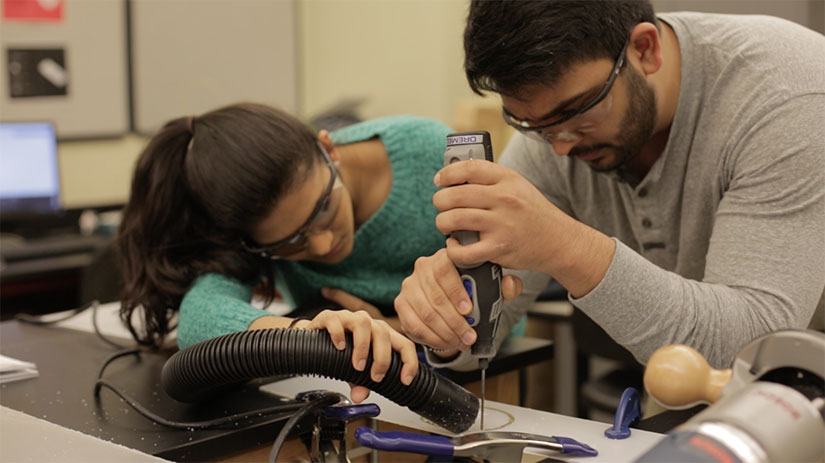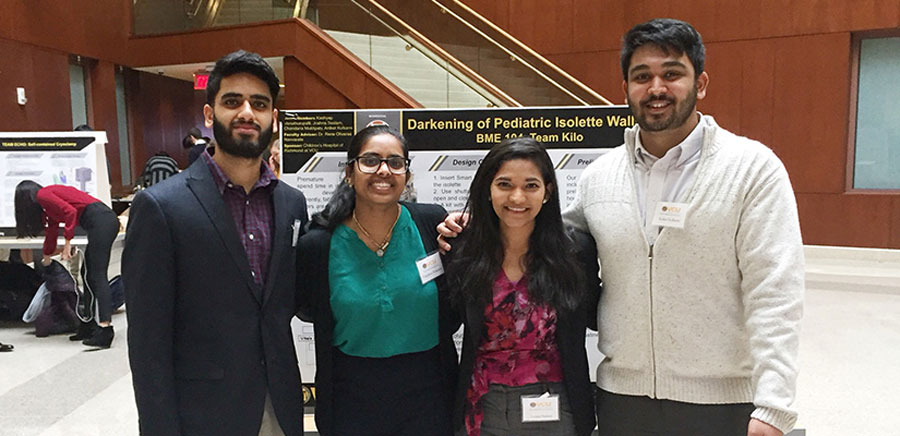By Rebecca E. Jones
The Brise-solette student team of Virginia Commonwealth University has been selected to participate in the 2018 Student Innovation Showcase hosted by the National Academy of Inventors (NAI). The VCU team is one of only six in the nation chosen to compete in the showcase, held April 6, 2018, at the Mayflower Hotel, Autograph Collection in Washington, D.C. as the closing event of the Seventh Annual Conference of the NAI. Finalists were selected based on the novelty, potential benefit to society, potential for commercialization and technical feasibility of their technology.
Aniket Kulkarni, Chandana Muktipaty, Joshna Seelam and Kashyap Venuthurupalli, all biomedical engineering seniors, are making isolettes, or incubators, for premature infants safer and more effective by controlling light stimuli. Hospital staff often use blankets to cover an isolette to limit light and help an infant sleep, but this hinders monitoring of the infant. Covers also pose a risk of infection and create an environment that is too dark, which can cause fluctuating vitals and hinder optical development.

Seelam and Kulkarni test a circular saw for cutting glass to the desired shape for their team's specialty isolette.
The VCU team developed a novel adaptive kit that allows neonatal staff to control the opacity of isolette walls at different levels, from clear to opaque. This allows the staff to create a restful environment for the infant, while at the same time providing visual monitoring of the patient. The team is also adding safety features to the kit that would help clinicians respond more quickly in case of emergencies. The name Brise-solette is from the French term “brise soleil” (“sunbreaker”), which describes an architectural awning.
René Olivares-Navarrete, D.D.S., Ph.D., assistant professor in the Department of Biomedical Engineering, is faculty adviser for this Capstone Design project team.
“This team of students embodies the VCU Engineering ethos. They are innovative, dedicated to excellence and committed to improving health care delivery,” said Barbara D. Boyan, Ph.D., Alice T. and William H. Goodwin Chair and dean of the VCU School of Engineering and a Fellow of the National Academy of Inventors. “Their creative approach to solving this problem in the neonatal intensive care unit has tremendous potential for pediatric patients in the home environment, as well. Naturally, I encouraged them to compete for the NAI student showcase and am thrilled — but not surprised — that they are finalists.”
Kulkarni explained that, given the prestige of the contest and organization, they submitted their innovation to the showcase as a sort of “Hail Mary,” never dreaming they would go on to be finalists. As gratifying as this achievement is, he is even more proud of the invention itself.
“The Brise-solette shows how technology can really advance health care in an important way. The current approach of putting blankets on isolettes is very primitive,” he said. “Our innovation shows how basic practices can be improved with automation, technology and scientific progress.”
Seelam agreed and noted that the mentorship she and her team members received at VCU was key to the success of this project.
“The School of Engineering has been extremely helpful. There’s no spoon feeding here, but if you take the initiative, they help you make it real,” she said. “We meet with our adviser weekly — or more, and the school also helped with funding. We were fortunate to receive a Sternheimer Award, which promotes innovative and entrepreneurial projects. Now VCU’s Innovation Gateway is helping us lay the groundwork toward intellectual property filing and the da Vinci Accelerator is helping with possible future commercialization. The academic and team working skills we have learned during our college years are what's helping us to push this project forward and we are all very excited about it.”
The National Academy of Inventors launched the Student Innovation Showcase in 2017 to offer a unique platform for students to demonstrate their world-changing inventions to the highest caliber innovators. In addition to the rare opportunity for recognition in a high-level academic atmosphere, selected student teams will also be matched with NAI Fellows, with expertise in their shared field, who will provide mentorship to guide their technology through the commercialization process. During the final day of programming, NAI members and guests will interact with these emerging student innovators, and ultimately engage with those whose inventions hold the greatest capability to translate positive impact our society.
The Brise-solette team joins five competing teams representing the following universities at the 2018 Student Innovation Showcase: Johns Hopkins University, The George Washington University, University of South Florida, Worcester Polytechnic Institute, and University of Southern California.
The NAI Annual Meeting features presentations and networking with renowned inventors and industry partners from across the U.S. and around the world. The meeting serves as an arena where innovation and entrepreneurship, leading to local and national economic development, are recognized, honored and cultivated. The 2018 NAI Conference––Exploring the Intersections of Innovation––aims to open the dialogue surrounding the discovery of common pathways of innovation, with intention to collaborate and advance our world into the future. Follow the progress of the Brise-solette team during the conference on Twitter using the hashtag #StudentsInvent.
